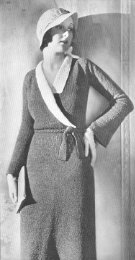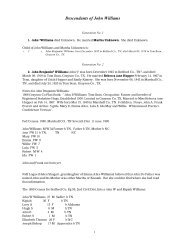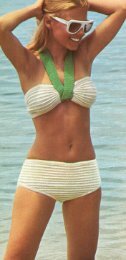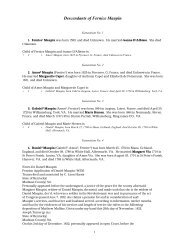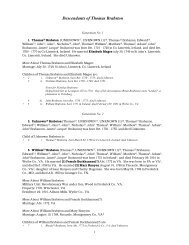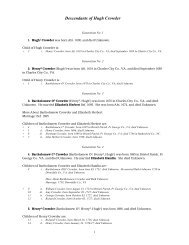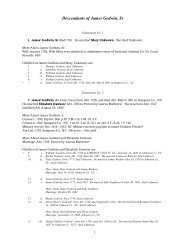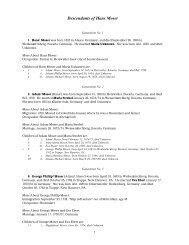TABLE of CONTENTS - Cemetarian
TABLE of CONTENTS - Cemetarian
TABLE of CONTENTS - Cemetarian
Create successful ePaper yourself
Turn your PDF publications into a flip-book with our unique Google optimized e-Paper software.
Brief History <strong>of</strong> Sewing Patterns..... pg 2<br />
Advance Pattern Company....................pg 8<br />
Butterick Pattern Company..................pg 12<br />
Du Barry Pattern Company...................pg 19<br />
Hollywood Pattern Company.................pg 21<br />
Mail Order and Misc Companies..........pg 24<br />
McCall Pattern Company........................pg 28<br />
Simplicity Pattern Company..................pg 34<br />
Vogue Pattern Company.........................pg 41<br />
<strong>TABLE</strong> <strong>of</strong> <strong>CONTENTS</strong><br />
This compilation <strong>of</strong> pattern information comes from many sources. Namely the past<br />
several years <strong>of</strong> handling vintage sewing patterns, magazines and researching with other<br />
pattern dealers. It is hours and days and years <strong>of</strong> compiling lists and scans and various<br />
information. My thanks go out to all <strong>of</strong> the wonderful patternistas who have sent me<br />
bits and pieces <strong>of</strong> information through the years but most especially to my Dear<br />
Husband for giving me tons <strong>of</strong> help and encouragement to research all <strong>of</strong> the data to<br />
compile for your research benefit.<br />
Rita Holcomb/cemetarian<br />
April 27, 2012<br />
Please use for your own research and do not copy or resale.
About Dating Vintage Sewing Patterns<br />
The pattern number is only ONE indicator <strong>of</strong> the date on vintage sewing patterns. You<br />
can’t use the number alone because the companies would start over again when they got<br />
to a certain level. You must consider the general silhouette <strong>of</strong> the clothing along with<br />
other factors such as hair, price, sizing and envelope style and logo placement you can<br />
get pretty close to the issue or copyright date. Please be aware that even if a pattern is<br />
dated, it could have been in production for years and could even be a re-release <strong>of</strong> a<br />
previous number.<br />
Style eras <strong>of</strong>ten crossed decade lines. For instance it is very difficult to tell a 1938<br />
pattern from a 1941 pattern. The basic style and design elements were the same. The<br />
same thing applies for 1959-1961 and again in the 60s and 70's. There is more<br />
difference between 1964 and 1967 that there is between 1969 and 1971.<br />
Besides the general look and art work <strong>of</strong> vintage patterns, the sizing can be a very good<br />
indicator. In the beginning <strong>of</strong> Home Patterns, the bust measurement is <strong>of</strong>ten the only<br />
measurement given. By the 1940s patterns gave bust and hip measurements but <strong>of</strong>ten<br />
the waist was not given (due to the fact that the sewist could change that element).<br />
Until 1956 a Size 12 was for a 30 inch bust. In 1956 sizing changed and a Size 12 was<br />
for a 32 inch bust. In mid 1967 the standard changed once again and a Size 12 became a<br />
34 inch bust and remains so today. So if you are trying to date something near the year<br />
<strong>of</strong> size change, the size can be a great clue.<br />
After several years selling and handling old sewing patterns and catalogs, I have<br />
compiled this list <strong>of</strong> dates and pattern numbers. Since most patterns are not printed<br />
with the copyright information on them this list is computed using information from<br />
magazines, pattern books and other published sources. The best I can do most <strong>of</strong> the<br />
time is assume that if a pattern is published in a catalog that is it's date <strong>of</strong> release.<br />
There are <strong>of</strong> course crossovers and some patterns are rereleased. So there is definitely<br />
room for error in my calculations.<br />
This guide is meant as just that.......A GUIDE. It is not a definitive copyright date<br />
source.
Victorian 1865-1895<br />
In the mid to late 1860s slopping shoulders, tiny waists and very wide skirts were the<br />
fashion ideal.<br />
Edwardian-La Belle Epoque 1895-1920<br />
From 1895 to 1920 there were several subtle changes in the silhouette. In 1890<br />
narrower skirts with HUGE Leg O Mutton sleeves were the rage. By 1904 the S curve<br />
corset was developed to give women the Pouter Pigeon look and in 1910 the entire shape<br />
s<strong>of</strong>tened and narrowed to a flowing straight line with little emphasis on curves.
1920-1929<br />
After the War to End all Wars, (World War I), the world was in a celebratory mood and<br />
fashion changed drastically. Women's clothing became less restrictive and hemlines<br />
climbed higher (not as high as most people think but higher than they had ever been).<br />
Dropped waists and bound bosoms gave a boyish silhouette, along with bobbed hair and<br />
asymmetrical hemlines. But just to say all Twenties were Flappers is wrong. The move to<br />
the carefree youthful Flapper was a gradual movement and not every woman grasped the<br />
concept.<br />
1930-1939<br />
1930's With the Great Depression looming on the horizon many women who had<br />
previously lived a life <strong>of</strong> luxury with a huge staff to maintain their life styles, were<br />
suddenly thrust into a world where dressing simpler during the day was a simple matter
<strong>of</strong> practicality. The DAY Dress or House Dress was born and the more complicated and<br />
expensive fabrics were saved for evening wear. Hemlines plunged as did spirits, and the<br />
female figure made a reappearance. Skirts narrowed at the hip with a flare (bias cut or<br />
pleats) at the hemline. By the late Thirties, hemlines were creeping upwards once again<br />
and dresses (or frocks) were becoming more flattering due to an extensive use <strong>of</strong> Rayon<br />
which hangs s<strong>of</strong>tly and lends it's self to drapes and pleats. Shoulders were getting wider<br />
You will sometimes find NRA seals on patterns which can help you date them between<br />
1933-1935. The National Industrial Recovery Act (NIRA), <strong>of</strong>ficially known as the Act<br />
<strong>of</strong> June 16, 1933 was part <strong>of</strong> President Franklin D. Roosevelt's New Deal. It authorized<br />
the President to regulate industry and permit cartels and monopolies in an attempt to<br />
stimulate economic recovery from the Great Depression, and established a national<br />
public works program. The Act was implemented by the National Recovery<br />
Administration and the Public Works Administration. The NIRA was set to expire in<br />
June 1935, but the U.S. Supreme Court held Title I <strong>of</strong> the Act unconstitutional on May<br />
27, 1935, in Schechter Poultry Corp. v. United States, 295 U.S. 495 (1935) (making the<br />
issue moot).<br />
1940-1949<br />
1940's It's very hard to tell a 1939 from a 1940 unless the pattern is actually dated.<br />
There were no major changes between 1938 and 1941........so if it's extremely important<br />
to you to have a definite date, I'm sorry there isn't an answer. By 1942, when America<br />
entered the 2nd World War, Day Frocks became even more important. Rationing <strong>of</strong><br />
fabrics, metals and synthetics as well as the economic impact made protection <strong>of</strong><br />
clothing very important. Hemlines climbed higher than ever due to rationing <strong>of</strong> fabric.<br />
Pullover dresses and tops became necessary due to rationing <strong>of</strong> metal for buttons.<br />
Aprons and House Dresses to wear at home, Military styled suits for the <strong>of</strong>fice worker
and <strong>of</strong> course trousers for the Rosie the Riveter. Evening clothes were still in vogue, but<br />
were simply styled and <strong>of</strong>ten redone older clothing.<br />
By the late 40's hemlines were once more below the knee and stayed there until the mid<br />
50's.........the emphasis was on the female form once again. Draping and pleating and<br />
nipped waistlines were once more fashionable but on a s<strong>of</strong>ter and less rigid scale.<br />
1950-1959<br />
Ah! The 50's.........Eisenhower, Rock N Roll, Suburban Life. A car in every garage and a<br />
chicken in every pot. What exactly were the 50's? Many things. In fashion it was the<br />
NEW AGE look, which wasn't really NEW. Tiny waist, wide skirts (just shorter this<br />
time), not much different from the 1850's. But WOW, did the designers know how to<br />
capitalize on the affluence <strong>of</strong> the 50's. Extreme's is perhaps the thing that most<br />
signifies this era. If one tuck or pleat was good then many were better. High collars,<br />
asymmetrical bodices and big ruffles were all the rage. Most pattern companies took<br />
advantage <strong>of</strong> this new decade and published Designer series.<br />
Trends seemed to last about one or two seasons and then moved on to something else. In<br />
the early 50's, the styles aren't much different from the very late 40's, except in<br />
fabrics. Heavier brocades and cottons that held their shape. Hemlines were still low, but<br />
petticoats were making a comeback.<br />
By the mid 50's there were two extremes.............very slim and narrow sheaths or very<br />
wide and full skirts. Dropped waists were once more in vogue, but this time it was to<br />
accentuate the waistline not to hide it. Instead <strong>of</strong> being corset free, these styles<br />
required heavy duty long line foundations.<br />
The later 50's brought on extreme figure manipulation as shown with the Bubble Dress,<br />
and other wild and crazy silhouettes.
1960-1969<br />
The 60's started much like the 50's ended. Shirtwaist dress with full skirts or slim<br />
skirts and lots <strong>of</strong> petticoats. Then came the Jackie era. Slim skirts with gathers at the<br />
waist line, shell tops and boxy jackets or full length Duster Coats. By the mid 60s<br />
waistlines had once again almost disappeared. A line dresses with either an Empire or<br />
NO waist were the rule.<br />
By the middle <strong>of</strong> the decade the silhouette was slim with petticoats left in the past.<br />
Pants were becoming more prevalent for casual wear and no longer just for beach wear.<br />
By the end <strong>of</strong> the decade Pant Suits were acceptable in some work places and schools.<br />
The Hippie movement made Blue Jeans an every day fashion and long dresses were not<br />
just for evening.<br />
And <strong>of</strong> course we all know <strong>of</strong> the impact <strong>of</strong> the Mini skirt and the MOD British Invasion.<br />
Pants seemed the lesser <strong>of</strong> two evils when compared to the mini skirt.
1970-1979<br />
The 70's gave us Boho with elaborate trims and luscious fabrics in flowing lines. The<br />
bigger the pant hem the better. Low rise on pants started the decade and got lower and<br />
lower. Hot pants and halter tops were s<strong>of</strong>tened with overskirts (reminiscent <strong>of</strong> the 50's<br />
overskirts). The middle <strong>of</strong> the decade took us into a more Romantic atmosphere. Long<br />
sleeves, high necklines, s<strong>of</strong>tly feminine and unrevealing. From the mid 70's style was<br />
pretty much anything goes. Long or short, fitted or loose; It didn't matter.....just Do<br />
your own Thing!
Advance Pattern Company<br />
The house brand <strong>of</strong> J C Penny Company from 1933 until it and was purchased by Puritan<br />
Fashions in 1966.<br />
Original prices began at 10 cents and climbed to 75 cents by 1964.<br />
Since Advance did not date their patterns, it is difficult to pin down actual dates. The<br />
information below is an approximation based on observation and experience, styling<br />
details and historical research <strong>of</strong> designers.<br />
1933-1939<br />
Advance started with the number 800 and finished the decade with the 2400 series.<br />
Notice the Eiffel Tower in the logo, implying these were Paris Designs.<br />
1933 896-1060<br />
1938 1935-2606<br />
1939 2121-2425
1940-1949<br />
The decade started in the 2300 sequence and finished around 5300.<br />
1940 2426-2606<br />
1941 2607-2998<br />
1942 2999-3150<br />
1943 3151-3634<br />
1944 3635-3822<br />
1945 3623-4079<br />
1946 4080-4425<br />
1947 4426-4751<br />
Font and placement <strong>of</strong> the Name changed around 1948. One <strong>of</strong> the companies most<br />
popular patterns was the Buttons and Bows apron used as a give away promotion in 1948<br />
for the Movie "Pale Face" staring Jane Russell and Bob Hope.<br />
1948 4752-5051<br />
1949 5052-5370
1950-1959<br />
The 1950's were a more prolific time for Advance. They started the decade in the 5300<br />
series and finished around 9200. They also featured many celebrity and designer<br />
patterns, including the I LOVE LUCY pattern.<br />
There was small issue <strong>of</strong> Import Designer's which have not all been discovered yet. But<br />
they did include #101 Carven, #103 Simonetta, #113 Aurora Battilocchi and #115<br />
Fontana.<br />
American designers were issued in the regular line (without special numbers) that<br />
included Adele Simpson, Suzy Perette and Luis Estevez and there was a line <strong>of</strong> New York<br />
Times Designer Fashions called Patterns <strong>of</strong> the Times.<br />
The Block letter font stays prominent and at the top.
1950 5371-5678<br />
1951 5679-5996<br />
1952 5997-6266<br />
1953 6267-6609<br />
1954 6610-6939<br />
1955 6940-7135<br />
1956 7701-8185<br />
1957 8186-8507<br />
1958 8508-8868<br />
1959 8869-9242<br />
1960-1969<br />
Advance sold to Puritan in 1966 and the last known number group is the 3500's. From<br />
1960-1965 they were quite prolific and produced many wonderful and stylish patterns.<br />
As one <strong>of</strong> the last companies to go to printed patterns the announced the fact by<br />
putting "A Printed Pattern" on each envelope.<br />
The block letter font moved to the side in 1960, moved to the bottom with the Sew Easy<br />
indication around 1962 and then moved back to the side around 1964.<br />
1960 9243-9630
1961 9631-2000<br />
1962 2001-2500<br />
1963 2501-3400<br />
1964 3401-3519
Butterick Pattern Company<br />
Created by Ebenezer Butterick in 1863. The first patterns were for men and boy's<br />
clothing and were cut and folded by members <strong>of</strong> his family. By 1866 they began supplying<br />
women's dress patterns.<br />
In 1867, Butterick published the "Ladies Quarterly <strong>of</strong> Broadway Fashions" and in 1868<br />
added the "Metropolitan". In 1873 "The Delineator" began publication. The first<br />
pattern instruction sheet was introduced in the 1920's and was called the "Deltor" and<br />
perhaps helped the Butterick Company survive the Depression when other pattern<br />
companies failed .<br />
In 1948, Butterick started printing markings directly onto the tissue pattern.<br />
Pre 1930<br />
Prior to the 1930's Butterick had no real design or logo plan. You will find many
different types <strong>of</strong> lettering and information. Basic styles will be your best indicator <strong>of</strong><br />
when these patterns were made.<br />
1929 1529-2688<br />
1930-1939<br />
1930's Butterick number series appears to have started around the 3000 number and<br />
continued through 8900. Since none <strong>of</strong> these patterns are dated, it is impossible to<br />
verify, but you can follow the sequence <strong>of</strong> styles through the years and get a rough<br />
estimate. Butterick used many different logo placements in this era so the logo is not a<br />
good indicator. Style and length are better indications <strong>of</strong> the dates.<br />
1932 4190-4605<br />
1933 3976-5506<br />
1934 5006-5585<br />
1935 6162-6205<br />
1936 6670-6718<br />
1939 8187-9135
1940-1949<br />
Butterick was still changing the logos around and trying to settle on a distinct "look"<br />
Some say Companion and some don't.<br />
1940 9136-1260<br />
1941 1261-1767<br />
1942 1768-2351<br />
1943 2353-2823<br />
1944 2824-3183<br />
1945 3184-3598<br />
1946 3599-4017<br />
1947 4018-4377<br />
1948 4378-4738<br />
1949 4739-5117<br />
1950-1959<br />
In 1951 the found their envelope design niche. A colored box in the upper left hand<br />
corner with block letters "Butterick Printed Pattern". They moved the logo again in<br />
1959 and removed the colored background <strong>of</strong> the box. Butterick pattern #6015 (the<br />
Walk-away Dress) was such a popular phenomenon that the company stopped production<br />
<strong>of</strong> all other patterns until the demand for #6015 stopped. No other pattern before or<br />
since has been such a best seller.
1950 5118-5554<br />
Color Block Added<br />
1951 5555-5971<br />
1952 5972-6350<br />
1953 6351-6765<br />
1954 6766-7160<br />
1955 7161-7566<br />
1956 7567-7979<br />
1957 7980-8349<br />
1958 8350-8763<br />
Block on the Side<br />
1959 8764-9062
1960-1969<br />
1960's started with the 9000 series and the Side logo <strong>of</strong> block letters. The numbers<br />
started over again with 1000 in the early 60's and Butterick moved the block letters to<br />
the top <strong>of</strong> the envelope in 1966.<br />
In the late 60s, there was a Butterick Boutique line.<br />
1960 9063-1499<br />
1961 1500-2139<br />
1962 2140-2271<br />
1963 2300-3000<br />
1964 3005-3158<br />
1965 3159-4158<br />
1966 4159-4235<br />
Block on Top<br />
1967 4166-4416<br />
1968 4698-4951<br />
1969 4952-5751
1970-1980<br />
1970's showed few changes except for the serif font, until 1979 when the company<br />
reverted once again to Block Letters. These are a bit different from the earlier fonts<br />
but the simplicity <strong>of</strong> the styles as well as the pricing give you a clear difference between<br />
the eras.<br />
Serif on Top<br />
1970 5800<br />
1971 6300<br />
1972 6800<br />
1973 3000<br />
1974 3500<br />
1975 3900<br />
1976 4000<br />
1977 4500<br />
1978 5000<br />
Big Block on Top<br />
1979 5500
Du Barry Patterns<br />
Manufactured by Simplicity Pattern Company, DuBarry patterns began in 1931 for selling<br />
exclusively at Woolworth Company Stores. The latest date found is 1947. Original<br />
prices ranged from 10 cents to 15 cents.<br />
Earliest patterns are du Barry and later changed to Du Barry.<br />
Between 1933 and 1935 Du Barry patterns were marked with the NRA logo to support<br />
the National Recovery Act.<br />
Because <strong>of</strong> their short production time they are harder to find and are considered<br />
highly collectible.<br />
Du Barry patterns are hard to date by number. They seem to skip around and some have<br />
a B behind the number and some have a D in front <strong>of</strong> the number and there are even<br />
some with a T. There are a few with copyright dates printed on the envelope but most<br />
are not dated.<br />
1931-1932 100-800<br />
1933-1935 900-1000<br />
1936-1938 1000-2000<br />
1939 2146B-2407B<br />
1931-1939
1940 2408B-2561B<br />
1941 2562B-2666B<br />
5001-5126<br />
1942 2716B-2769<br />
5273-5500<br />
1943 5501-5752<br />
1944 5753-5972<br />
1945 5973-6140<br />
1946 6141-6212<br />
1940-1947
Hollywood Patterns<br />
Created by Conde Nast in 1932, the Hollywood Pattern Company quickly became popular<br />
due to the photos <strong>of</strong> favorite radio and movie stars that graced the envelopes.<br />
Collectors <strong>of</strong> Hollywood memorabilia <strong>of</strong>ten look for sleeves with their favorite stars.<br />
Original pattern prices ranged from 15 cents to 25 cents. Their manufacture stopped<br />
after World War II and due to their short production span they are harder to find and<br />
considered highly collectible.<br />
Hollywood patterns with the Movie Stars are sometimes easy to date. If the bio<br />
mentions "Starring in...." you can go to the Internet Movie Data Base and search the<br />
Star and the particular movies and get real close to the year.<br />
Dating on the early Hollywood patterns doesn't seem to be as important as the front<br />
cover content and the stars that were featured.<br />
A starlette knew they had arrived when they were featured on a Hollywood Pattern<br />
Cover. Their head shot and a personalized design and artist rendering was there for the<br />
world to see. This type <strong>of</strong> publicity during the Great Depression entered more homes<br />
than magazines and newspapers.<br />
1932 1000-1099<br />
1933 1100-1199<br />
1934 1200-1299<br />
1935 1300-1399<br />
1936 1400-1499<br />
1937 1500-1599<br />
1932-1939
1938 1600-1705<br />
1939 1706-1928<br />
1940-1947<br />
The patterns with a STAR from the War years are the most prized <strong>of</strong> all.<br />
1940 1929-1998 400-558<br />
1941 559-788<br />
1942 804-1021<br />
1943 1022-1255<br />
1944 1256-1489<br />
1945 1490-1770<br />
1946 1770-1972<br />
1947 1972-2170<br />
Here is a partial list <strong>of</strong> some <strong>of</strong> the Stars and wanna be stars.<br />
Adrienne Ames Lucille<br />
Fairbanks<br />
Vivian Leigh Ginger Rogers<br />
Lucille Ball Glenda Farrell Margaret<br />
Lindsay<br />
Ann Rutherford<br />
Joan Bennett<br />
Geraldine<br />
Fitzgerald<br />
Carole Lombard Ann Sheriden<br />
Joan Blondell Susanna Foster Anita Louise Anne Shirley<br />
Katherine Booth Kay Francis Ida Lupino Sylvia Sidney<br />
Jane Bryan Betty Furness Mary Maguire Ginny Sims
Mary Carlise Franciska Gaal Patricia Moran Gale<br />
Sondergaard<br />
Claudette<br />
Colbert<br />
Betty Grable Jean Muir<br />
Barbara<br />
Stanwyck<br />
Bette Davis Bonita Granville Martha<br />
O'Driscoll<br />
Gloria Stuart<br />
Olivia De<br />
Havilland<br />
Katherine<br />
Hepburn<br />
Maureen<br />
O'Hara<br />
Verree Teasdale<br />
Delores Del Rio Ann Harding<br />
Maureen<br />
O'Sullivan<br />
Ruth Warrick<br />
Gloria Dickson Rochelle Hudson Merle Oberon Marie Wilson<br />
Claire Dodd Dorothy Jordan Glenda Parnell Marjorie<br />
Woodworth<br />
Ellen Drew Ruby Keeler Pat Patterson Jane Wyman<br />
Ann Dvorack Lola Lane<br />
Shirley<br />
Patterson<br />
Charlene Wyatt<br />
Frances Dee Priscilla Lane Barbara Read<br />
Patricia Ellis Rosemary Lane
Mail Order Companies<br />
Mail order patterns were the answer for rural homemakers for the most <strong>of</strong> the 20th<br />
century. Each magazine had a section for the homemaker to order patterns, and this<br />
included Progressive Farmer and Grit. The list is enormous and some patterns had the<br />
designer's name and some were generic with a simple number.<br />
There were multiple Mail Order Companies that supplied sewing and crafting patterns to<br />
magazines and newspapers. Even Male oriented magazines such as Country Gentleman and<br />
Progressive Farmer had a Woman's Section dedicated to fashion.<br />
Most Mail Order patterns came in an envelope marked with the name <strong>of</strong> the publication.<br />
So you might find the very same pattern but in an envelope from Grit or Progressive<br />
Farmer. Unless the pattern is in an envelope with a postmark date, it is very difficult to<br />
pin them down to a specific date. The patterns stayed in circulation until there was no<br />
longer a demand so the same pattern could be in publication for 4-6 years.<br />
One way to help date mail order patterns is the post mark on the original envelope.<br />
Metered Mail should be stamped. Undated meters are as follows:<br />
• "SEC 564 PL&R" , 1 or 1 1/2 cent or similar = early 1930's to early 1950's<br />
• "SEC 34.66 PL&R" , 1 1/2 cent meter = 1950's<br />
• "BULK RATE" the postage helps narrow down the range:<br />
• 2 1/2 cent = July 1960 to Dec 1962<br />
• 2 5/8 cent meter = 1963<br />
• 2 3/4 cent meter = 1964<br />
• 2 7/8 cent meter = Jan 1965 to Dec 1967<br />
• 3 6/10 cent meter = Jan 1968 to Jun 1969<br />
• 3 8/10 cent meter = Jul 1969 to May 1971<br />
If the meter has a serial number the number might give a clue to the date:<br />
• PB with 4 digit numbers are usually 1945 or earlier<br />
• PB with 5 digit numbers 01000 to 01549 or PB 55000 to 56999 are usually 1933-<br />
1940<br />
• PB with 5 digit numbers 01550 to 01999 are late 1930s to 1950's<br />
• PB with 5 digit numbers 05000 to 05499 or PB 5400 to 54999 are usually 1960s<br />
or 1970's<br />
• PB with 5 digit numbers 57000 to 59999 cane be anywhere from 1930 to 1970<br />
• PB with 6 digit numbers are usually 1980 and later.
Below is a sampling <strong>of</strong> Mail Order and Misc pattern companies. These are basically<br />
undatable, so the best we can do is a generic era by style.<br />
Fairloom, Superior Patterns (which were circulated through the Sears Roebuck Co),<br />
American Designer<br />
Pictorial Review, Anne Adams, Marian Martin
Modes Royale, Originator, New York<br />
Lady Louise, Woman's Day, Parade, Excella
Prominent Designer, Modern Pattern, Ladies Home Journal, Patt-O-Rama<br />
Spadea, Woman's World, The American Weekly<br />
A few others........ but there are many many more.<br />
Work Basket<br />
Ladies Home Companion<br />
Alice Brooks<br />
Iris Lane<br />
Priscilla<br />
Peerless<br />
Pictorial Review<br />
Star<br />
And a world <strong>of</strong> Needlecraft Magazines. Nearly every publication had a pattern and<br />
needlecraft section.
McCall Pattern Company<br />
McCall Pattern Company started in 1870 in New York City. James McCall, an immigrant<br />
from Scotland was a Tailor with a small shop who kept up with European fashion trends<br />
and worked as a U S Agent for the English pattern company The Royal Chart.<br />
He began to design his own patterns and published a four page magazine, "The Queen" to<br />
promote and advertise his patterns.<br />
When James McCall died in 1884, his company continued to flourish. The magazines name<br />
changed to "The Queen <strong>of</strong> Fashion" and reached a circulation <strong>of</strong> more than 75,000.<br />
McCall's started printing directly onto their patterns in 1919 and in the 1920's<br />
introduced full color printing on their envelopes illustrations. It has been stated that<br />
ALL McCall's have a copyright date, but I have found a few undated ones. But it is safe<br />
to say that nearly ALL McCall patterns are dated and they are the only company to<br />
consistently do so.<br />
McCall patterns had no S until 1951<br />
1914 5438-5781<br />
1925 2783-4254<br />
1928 4900-5380<br />
1920-1929
1930-1939<br />
The grey moved to the side and changed again around 1932. They lost the grey and went<br />
with a cleaner look. By 1935 the name was once again at the top but didn't stay long.<br />
1934 7300-7400<br />
1936 8568-9018<br />
1938 9172-9743<br />
1939 3014-3504<br />
1940-1949
Companies re-issued patterns if they were popular and good sellers, especially during the<br />
war years. The number ranges found in Style News magazines reflect that reprinting.<br />
Numbers seem to range from 3500-7850 in the decade <strong>of</strong> the 40's, with some carried<br />
over from the 30's and into the 50's.<br />
In the early 40's McCall switched to a Script font on the right side.<br />
1940 3505-4001<br />
1941 4002-4518<br />
1942 4519-5027<br />
1943 5028-5439<br />
1944 5440-5852<br />
1945 5853-6276<br />
1946 6277-6688<br />
1947 6689-7061<br />
1948 7062-7453<br />
1949 7454-7867<br />
1950-1959<br />
By 1952 McCalls added an apostrophe S to their logo and lost the script for a block<br />
letter font.<br />
1950 7876-8335
McCall’s (S added in 51)<br />
1951 8372-8764<br />
1952 8814-9252<br />
1953 9267-9640<br />
1954 9661-3125<br />
1955 3126-3504<br />
1956 3505-3920<br />
1957 3995-4413<br />
1958 4430-4866<br />
1959 4871-5307<br />
1960-1969<br />
Logo switched sides in 1963 and changed completely in 1965 and Number series started<br />
over with 1000-2249. The colored stripe continued into the mid 70's.<br />
1960 5308-<br />
1961 5800-<br />
1962 6200-<br />
Name Moved to Left Side<br />
1963 6863-
1964 7250-7515<br />
Color Stripe added<br />
1965 7747-8028<br />
1966 8200-<br />
1967 8674-<br />
1968 8900-<br />
1969 9604-2100<br />
1970-1979<br />
The Pounds Thinner line was started in 1970 with the side color swatch but with the girl<br />
in a bodysuit creating an optical interest. Logos changed and the numbering system kept<br />
going in 1975 with 4300-6500. In 1979 the logo changed once again with the numbering<br />
continuing into the 80's.<br />
1970 2250-<br />
1971 2770-<br />
1972 3100-3300<br />
1973 3500<br />
Start Multi Size<br />
1974 3900-<br />
Stripe Gone Block- Letters left side
1975 4300-4900<br />
Big Block at Top<br />
1979<br />
McCALL NEEDLEWORK<br />
1914 573-586<br />
1925 1467-1472<br />
1928 1532-1665<br />
1938 513-630<br />
1939 651-723<br />
1940 724-821<br />
1941 822-919<br />
1942 920-1015<br />
1943 1016-1082<br />
1944 1083-1155<br />
1945 1156-1220<br />
1946 1221-1294<br />
1947 1295-1343<br />
1948 1360-1437<br />
1949 1438-1498<br />
1950 1521-1585<br />
1951 1610-1647<br />
1952 1684-1749<br />
1953 1781-1827<br />
1954 1849-1939<br />
1955 1947-2031<br />
1956 2075-2123<br />
1957 2130-2184<br />
1958 2185-2333<br />
1959 2334-2368
Simplicity Sewing Patterns<br />
Simplicity Pattern Company, Inc is the baby <strong>of</strong> the bunch regarding pattern<br />
manufacturers. Started in 1927 by Joseph Shapiro and his son, his goal was to<br />
produce an easy to follow and economical 15 cent pattern. Of the four major<br />
pattern companies in the world today, Simplicity believes it is the worlds largest.<br />
It is the most prolific. Logo items change periodically.<br />
Simplicity patterns are <strong>of</strong>ten dated.<br />
Sometime the date is on the Instruction Sheet, sometime it is on the envelope<br />
and sometime it is not there at all. The dates here could be supposition so take<br />
nothing as fact but as merely a guideline.<br />
Simplicity also had pattern lines with a unique numbering series:<br />
Costumes in the 1930’s 7000 number sequence<br />
Needlework in the mid 1940’s 7000 number sequence<br />
Lingerie in the late 1930’s S600 Number sequence<br />
1927-1929
1930-1939<br />
Like so many <strong>of</strong> the other companies, Simplicity tried several "looks" before they<br />
settled on one.<br />
Simplicity used the NRA seal from 1933-1935<br />
1933 1287-1337<br />
1935 1700-1935<br />
1939 2955-3240
1940-1949<br />
By the 40's the font had changed to a script which had a more feminine appeal.<br />
Placement was on the side and stayed there.<br />
1940 3264-3625<br />
1941 3625-4046<br />
1942 4043-4479<br />
1943 4480-4845<br />
1944 4865-4999 1000-1177<br />
1945 1178-1195<br />
1946 1490-1882<br />
1947 1823-2274<br />
1948 2275-2688<br />
1949 2689-3043
SIMPLICITY DESIGNERS<br />
In 1949 Simplicity started a Designers Pattern Series with a designated 8000 number.<br />
This only lasted a few years until 1952. Some <strong>of</strong> these were reissued in the regular<br />
numbering sequence.<br />
1949 8000-8220<br />
1950 8221-8332<br />
1951 8333-8461<br />
1952 8447-8496
1950-1959<br />
The 50's brought little change, but by late in the decade they had added little red<br />
boxes.<br />
1950 3057-3379<br />
1951 3380-3758<br />
1952 3759-4136<br />
1953 4137-4520<br />
1954 4521-4956 1000-1026<br />
1955 4957-4999 1027-1408<br />
1956 1409-1865<br />
1957 1866-2330<br />
1958 2331-2791<br />
1959 2792-3296
1960-1969<br />
The side placement <strong>of</strong> the logo changed around 1965. Colored script naming across the<br />
top was the New Look. And in 1967 when the New Sizing went into effect they changed<br />
once again to a colored slash with Block lettering across the top.<br />
1960 3299-3734<br />
1961 3735-4100<br />
1962 4200-4699<br />
1963 4700-5399<br />
1964 5400-5899<br />
Name on Top in Color<br />
1965 5900-6399<br />
1966 6400-6999<br />
1967 7000-7499<br />
1968 7500-8099<br />
Color Line<br />
1969 8100-8699
1970-1990s<br />
The colored slash stayed with them until the late 70's when they went to what I call the<br />
White Corner look. Which was changed to the File Folder Look around 1982. In the<br />
90's a more contemporary look with large block letters was used.<br />
1970 8700-9200<br />
1971 9300-9799<br />
1972 9800-9999 5000-5399<br />
1973 5400-6299<br />
1974 6300-6799<br />
1975 6800-7299<br />
1976 7300-7899<br />
File Folder Look<br />
1977 7900-<br />
1978 8800<br />
White Corner<br />
1982 5700
Vogue Sewing Patterns<br />
In 1899 VOGUE Magazine published a weekly pattern feature, which showed the<br />
consumer a pattern that could be purchased by sending in 50 cents with the coupon.<br />
Only one size was available.............a 36 inch bust. By 1905 the once-weekly pattern<br />
service had evolved into an entire Pattern Department, thanks to Rosa Payne who<br />
convinced the editors to print one <strong>of</strong> her patterns.<br />
In 1909 Vogue was purchased by Conde Nast and the demand for "Vogue" designs<br />
became so large that Mr Nast increased the availability and widened the style range.<br />
The Vogue Pattern Company was formed in 1914 and department stores started selling<br />
the patterns in 1916.<br />
In the early 30's, Ladies Home Journal discontinued their HOME patterns and featured<br />
Vogue Patterns in their Fashion Section instead <strong>of</strong> the traditional Home Patterns.<br />
There were several different numbering sequences. Their Regular line, Childrens,<br />
Special Design and their Couturier line.<br />
Vogue Patterns made news in the fashion industry by announcing the availability <strong>of</strong> Paris<br />
Original Models in 1949, featuring leading French Couturiers.<br />
Conde Nast signed a licensing agreement in 1961, with Butterick to use and trademark<br />
the Vogue Pattern name.<br />
This list is compiled from various Vogue Magazines and counter books. There are gaps<br />
and as stated before, a pattern might be published for several years so once again, this<br />
is a guide line and not a definitive list.<br />
Vogue Regular<br />
1920-1929
1929 9204-9646<br />
Vogue Special Design<br />
1929 S3281-S3292<br />
Vogue Children<br />
1929 2976-1888<br />
Vogue Regular<br />
1932 5949-6062<br />
1936 7016-7366<br />
1939 8255-8574<br />
Vogue Special Design<br />
1932 S3583-S3584<br />
1939 S4109-S4189<br />
Vogue Couture/Couturier<br />
1939 233-298<br />
Vogue Children<br />
1932 3285-3088<br />
1939 3534-2189 229<br />
1930-1939<br />
1940-1949
Vogue Regular<br />
1940 8559-8911<br />
1941 8915-9234<br />
1942 9235-9591<br />
1943 9600-9900 5000-5031<br />
1944 5032-5334<br />
1945 5321-5626<br />
1946 5666-5954<br />
1947 5983-6284<br />
1948 6270-6655<br />
1949 6674-6953<br />
Vogue Special Design<br />
1940 S4183-S4269<br />
1941 S4270-S4345<br />
1942 S4346-S4430<br />
1943 S4431-S4517<br />
1944 S4518-S4600<br />
1945 S4602-S4682<br />
1946 S4688-S4758<br />
1947 S4761-S4839<br />
1948 S4840-S4944
1949 S4947-S4998<br />
Vogue Couture/Couturier<br />
1940 300-363<br />
1941 365-399 200-211<br />
1942 224-295<br />
1943 296-361<br />
1944 362-399 200-223<br />
1945 224-281<br />
1946 288-343<br />
1947 346-404<br />
1948 408-468<br />
1949 475-533<br />
Vogue Paris Original<br />
1949 1050-1081<br />
Vogue Junior<br />
1945 3002-3048<br />
1946 3052-3121<br />
1947 3122-3182<br />
1948 3190-3251<br />
1949 3261-3324<br />
Vogue Children<br />
1941 2230-2266<br />
1942 2267-2316<br />
1943 2319-2336<br />
1944 2342-2373<br />
1945 2375-2382<br />
1946 2385-2430<br />
1947 2435-2453<br />
1948 3190-3251<br />
1949 2541-2571
Vogue Regular<br />
1950 6973-7241<br />
1951 7248-7555<br />
1952 7556-7874<br />
1953 7928-8171<br />
1954 8176-8481<br />
1955 8492-8736<br />
1956 8786-9019<br />
1957 9025-9347<br />
1958 9352-9640<br />
1959 9641-9872<br />
Vogue Special Design<br />
1950 S4000-S4160<br />
1951 S4176-S4273<br />
1952 S4274-S4360<br />
1953 S4361-S4464<br />
1954 S4481-S4560<br />
1955 S4581-S4656<br />
1956 S4667-S4742<br />
1950-1959
1957 S4749-S4849<br />
1958 S4850-S4933 S4935-S4940<br />
1959 S4957-S4999<br />
Vogue Couture/Couturier<br />
1950 544-596<br />
1951 606-656<br />
1952 660-719<br />
1953 729-778<br />
1954 786-833<br />
1955 841-885<br />
1956 889-938<br />
1957 953-998<br />
1958 999-142<br />
1959 144-196<br />
Vogue Paris Original<br />
1950 1082-1121<br />
1951 1122-1161<br />
1952 1162-1201<br />
1953 1202-1241<br />
1954 1258-1281<br />
1955 1287-1314<br />
1956 1319-1352<br />
1957 1354-1391<br />
1958 1398-1431<br />
1959 1434-1472<br />
Vogue Junior<br />
1950 3333-3392<br />
1951 3398-3445<br />
1952 3452-3498<br />
1953 3504-3547
1954 3553-3591 1500-1571<br />
1955 3601-3625 1515-1547<br />
1956 3636-3641 1551-1566<br />
1957 1571-1592<br />
1958 1606-1629<br />
1959 1633-1643<br />
Vogue Children<br />
1950 2580-2602<br />
1955 1546<br />
1956 2740-2748<br />
1960-1969<br />
In the 60's Vogue started using the same number sequence for both Couturier and the<br />
Paris Original series. So I have combined them together under Designer patterns. All<br />
numbers have been found in various publications and I have taken the liberty <strong>of</strong> grouping<br />
the numbers under the year <strong>of</strong> the earliest publication. Some were promoted for 2 or 3<br />
years in later publications. So it's not uncommon to find a 1961 number in a 1963<br />
publication.<br />
Vogue Regular<br />
1960 9900-5100<br />
1961 5126-<br />
1962 5300-5732<br />
1963 5800-6093
1964 6153-6352<br />
1965 6353-6639<br />
1966 6950<br />
1967 7249<br />
1968 7250-7528<br />
1969 7713<br />
Vogue Couture/Couturier<br />
1960 198-211<br />
Vogue Paris Original<br />
1960 1473-1494 1000-1023<br />
1961 1039-1058<br />
1962 1072-1188<br />
1963 1192-1277<br />
1964 1320-1405<br />
1965 1431-1551<br />
1966 1553-1639<br />
1967 1666-1745<br />
1968 1866-2062<br />
1969 2006-2262<br />
Vogue Children<br />
1960 2814-2912 5041-5086<br />
Vogue Designer<br />
1960 1000-1496<br />
1961 1039-1058<br />
1962 1072-1188<br />
1963 1192-1277<br />
1964 1320-1405<br />
1965 1431-1551<br />
1966 1553-1685<br />
1967 1666-1864
1968 1866-2062<br />
1969 2063-2262<br />
Vogue Regular<br />
1970 7714-7950<br />
1971 7382-8155<br />
1972 7637-8464<br />
1973 8166-8700<br />
1974 8432-9094<br />
1975 8257-9376<br />
1976 8749-9620<br />
1977<br />
1978 9816-7216<br />
1979<br />
1980 7052-7702<br />
Vogue Designer<br />
1970 2238-2454<br />
1971 2412-2596<br />
1972 2644-2802<br />
1973 2551-2930<br />
1974 2975-1010<br />
1975 1043-1349<br />
1976 1129-1550<br />
1977<br />
1978 1559-2002<br />
1979<br />
1980 2307-2521<br />
1970-1980




